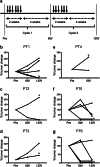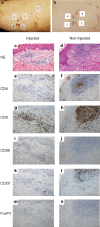Intratumoral injection of hemagglutinating virus of Japan-envelope vector yielded an antitumor effect for advanced melanoma: a phase I/IIa clinical study
- PMID: 32047956
- PMCID: PMC11027698
- DOI: 10.1007/s00262-020-02509-8
Intratumoral injection of hemagglutinating virus of Japan-envelope vector yielded an antitumor effect for advanced melanoma: a phase I/IIa clinical study
Abstract
Hemagglutinating virus of Japan (HVJ; Sendai virus) is an RNA virus that has cell fusion activity. HVJ-envelope (HVJ-E) is a UV-irradiated HVJ particle that loses viral replication and protein synthesis activity but retains cell fusion activity. We recently reported that HVJ-E has antitumor effects on several types of tumors. Here, we describe the results of a first-in-human phase I/IIa study in patients with advanced melanoma, receiving intratumoral administration of HVJ-E. The primary aim was to evaluate the safety and tolerability of HVJ-E, and the secondary aim was to examine the objective tumor response and antitumor immunity. Six patients with stage IIIC or IV progressive malignant melanoma with skin or lymph metastasis were enrolled. Patients were separated into two groups (n = 3 each) and received low and high doses of HVJ-E. Five of the six patients completed 4 weeks of follow-up evaluation; one patient discontinued treatment owing to progressive disease. Complete or partial responses were observed in 3 of 6 (50%) injected target lesions, 7 of 15 (47%) noninjected target lesions, and 10 of 21 (48%) target lesions. Induction of antitumor immunity was observed: activation of natural killer cells, a marked increase in interferon-γ levels in the peripheral blood, and infiltration of cytotoxic T cells into both injected and noninjected tumor lesions. Thus, intratumoral injection of HVJ-E in advanced melanoma patients showed safety and tolerability with local regression of the tumor mediated by antitumor immunity. The results suggest that HVJ-E might be a new treatment approach in patients with advanced melanoma.
Keywords: Adoptive immunity; Hemagglutinating virus of Japan-envelope; Intratumoral immunotherapy; Melanoma; Native immunity; Sendai virus.
Conflict of interest statement
Toshihiro Nakajima is the employee of GenomIdea, Inc. Toshihiro Nakajima and Yasufumi Kaneda are stock-holders (0.08 and 0.5%) of GenomIdea, Inc. The other authors declare no conflict of interest.
Figures



References
-
- Fujihara A, Kurooka M, Miki T, Kaneda Y. Intratumoral injection of inactivated Sendai virus particles elicits strong antitumor activity by enhancing local CXCL10 expression and systemic NK cell activation. Cancer Immunol Immunother. 2008;57:73–84. doi: 10.1007/s00262-007-0351-y. - DOI - PMC - PubMed
Publication types
MeSH terms
Substances
LinkOut - more resources
Full Text Sources
Other Literature Sources
Medical

